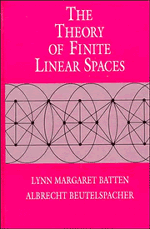Book contents
- Frontmatter
- Contents
- In memory of PAUL de WITTE 1931–1980
- Preface
- 1 The essentials
- 2 Complementation
- 3 Line sizes
- 4 Semiaffine linear spaces
- 5 Semiaffine linear spaces with large order
- 6 Linear spaces with few lines
- 7 d-Dimensional linear spaces
- 8 Group action on linear spaces
- Appendix
- Notation index
- Subject index
6 - Linear spaces with few lines
Published online by Cambridge University Press: 05 May 2010
- Frontmatter
- Contents
- In memory of PAUL de WITTE 1931–1980
- Preface
- 1 The essentials
- 2 Complementation
- 3 Line sizes
- 4 Semiaffine linear spaces
- 5 Semiaffine linear spaces with large order
- 6 Linear spaces with few lines
- 7 d-Dimensional linear spaces
- 8 Group action on linear spaces
- Appendix
- Notation index
- Subject index
Summary
Restricted linear spaces
By the Fundamental Theorem (see Theorem 1.5.5) we know that b ≧ v for any finite linear space. Moreover, the linear spaces with b = v are precisely the (possibly degenerate) projective planes. It is natural to ask “What are the finite linear spaces satisfying b = v + 1, b = v + 2,…?” Indeed, these questions have been asked and answered in J. Totten (1975, 1976a, b).
In this chapter we want, however, to consider a much more general situation. Following Totten, we call a finite linear space restricted if it satisfies (b − v)2 ≦ v. The aim of this chapter is to classify all restricted linear spaces.
In order to formulate the results one particular notion is important. Let A be an affine plane, and denote by п1,…, пm some of its parallel classes. Denote by S' any linear space with point set {п1,…, пm}. Let S be the linear space
whose points are the points of A and the sets п1,…, пm, and whose lines are the lines of A and the lines of L.
Then S is called an affine plane with the linear space S' at infinity.
For example, the Fano quasi-plane is the affine plane of order 2 with a near pencil at infinity (see Figure 6.1.1). (The affine plane of order 2 consists of the three “vertices” and the “midpoint” of the triangle.)
- Type
- Chapter
- Information
- The Theory of Finite Linear SpacesCombinatorics of Points and Lines, pp. 119 - 135Publisher: Cambridge University PressPrint publication year: 1993

